To fully appreciate the art of the carillon, it is essential to understand both its intricate structure and its construction process. We will begin by examining the shape and acoustics of an individual bell, followed by an exploration of the carillon's overall structure and playing techniques, which include the two primary methods of playing.
In comparison with contemporary standards, the carillons of earlier tim es were quite basic in their construction. The quality of the bells varied significantly, and their musical potential was often limited by rudimentary playing mechanisms. Despite these initial challenges, those dedicated to the craft eventually gained international acclaim as master bell makers, testament to their evolving skill and the growing sophistication of carillon construction.
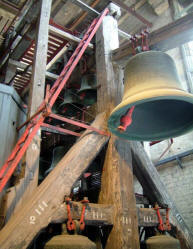
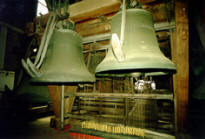
Shape and Acoustics
The shape of a traditional bell is based on two fundamental forms: the cup and the hollow sphere. The cup form, also known as the "open" bell, is more prevalent and is employed in various profiles for the majority of Western European tower bells. In this design, the sides gently flare out from the top for about two-thirds of their length, then broaden more dramatically towards the bottom.
The hollow sphere form, or "closed bell," shares an equally ancient origin and is available in as many shape variations as the open bell. The sound of the closed bell is produced by a loose pellet that moves within its interior. A well-known example of this type is the sleigh bell (French: grelot, German: Schlittenglocke).
Acoustically's, the closed bell is considerably more complex than other musical instruments, posing significant manufacturing challenges. The structure of a typical open bell includes various parts: the head or "vertex," shoulders, waist, the "sound bow," and the "lip" or rim at the lower edge, leading to the open "mouth." As the bell's flare increases outwardly, so does the thickness of the bell wall. This thickness reaches its maximum near the rim, precisely where the clapper or hammer strikes—an area known as the sound bow.
The mechanism for attaching or suspending the bell is usually a loop or crossed loops ("crown") at the vertex, although many modern bells simply use a bolt hole. The sound is generated either by an internal clapper, typically a rod with a knob, which strikes the sound bow (commonly used for manual playing or swinging the bell), or by an external hammer, activated by the automatic clock chime mechanism. This hammer is usually fixed near the bell and operated via remote control. Consequently, in a carillon performance, the bells themselves do not move.
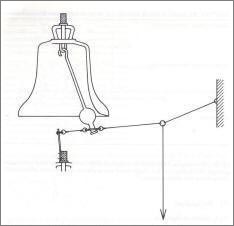
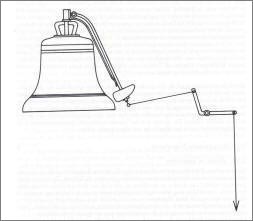
Due to the bell's resonant material, geometric shape, and characteristic profile, a stroke—whether from the inside or outside—produces not just a single tone but a spectrum of frequencies. This results in a cohesive mass of vibrations that are interconnected and interact with each other.
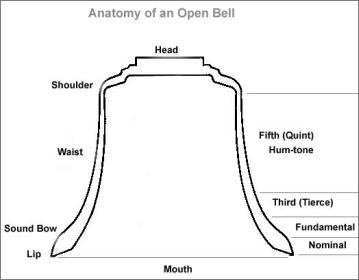
In a carillon bell, the five principal tones are meticulously tuned by the bell founders after the casting process (for more on this, see Jacob van Eyck and the Hemony brothers). The lowest of these partial tones is known as the "hum tone" (French: bourdon, German: Unteroktave), which resonates throughout the bell. An octave higher lies the "prime" or "fundamental" (French: principal, German: Prime), the most prominent tone heard when the bell is struck. This is often referred to as the "slagtoon" or "strike note," and its pitch determines the bell's note.
Above the fundamental is the "tierce" (French and German: Terz), a minor third higher, imparting a somewhat melancholic quality to the bell's tone.Following unsuccessful attempts in the past to cast a bell with a major third partial, the Technical University of Eindhoven conducted extensive research to develop the appropriate profile for such a bell. Through a highly successful collaboration with the "Koninklijke Eijsbouts" foundry in Asten, they achieved a significant milestone in 1985 by creating the first authentic major third bell.
In 1988, the first larger hand-played carillon featuring these innovative bells was installed in Our Lady's Church in Deinze, Belgium. Around the same period, a substantial carillon comprising 52 bells of this kind found its place in the Cristal Cathedral in Garden Grove, California, USA.
This particular tone, located above the sound bow, has historically sparked extensive discussions and research due to its unique effect. The next tone is the "quint" (French: quinte, German: Quinte) or "fifth," and finally, the "nominal" (French: nominal, German: Oberoktave), which sounds an octave above the fundamental and two octaves above the hum tone.

The profile of a bell plays a crucial role in shaping its modes of vibration, which determine not only the frequencies of the various partials but also their intensities. The lower section near the lip is the most vital vibrating part of the bell, as it is more flexible and carries more mass. In the immediate aftermath of a stroke, the three octaves—nominal, fundamental, and hum tone—set the basic pitch. However, other partials, whether tuned or untuned, significantly influence the bell's timbre.
These partials fade at varying rates, with higher frequencies diminishing more quickly than lower ones. As a result, the bell's tonal decay experiences a subtle and continuous transformation, varying with the size and specific profile of each bell. This dynamic evolution of sound contributes to the unique character and richness of a bell's tone.
The Structure of a Carillon
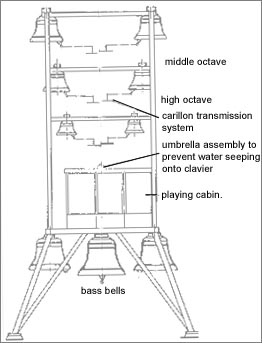
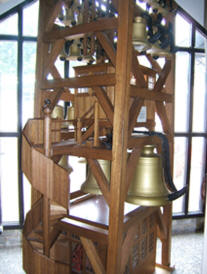
Carillons from the seventeenth century, especially the exquisite ones crafted by the Hemony brothers, typically featured about three chromatic octaves, encompassing around thirty-six bells. In contrast, an average modern carillon generally spans four to four and a half chromatic octaves, which translates to approximately forty-eight to fifty-six bells. In America, some carillons boast an impressive range of up to six octaves, featuring as many as seventy-seven bells.
The arrangement of bells within a carillon is usually determined by the bell chamber's space, the number and size of the bells, and the height and structure of the tower. When the bass bells are particularly large, they are often positioned below the playing cabin. This placement is preferred to achieve a more balanced and effective tonal distribution.